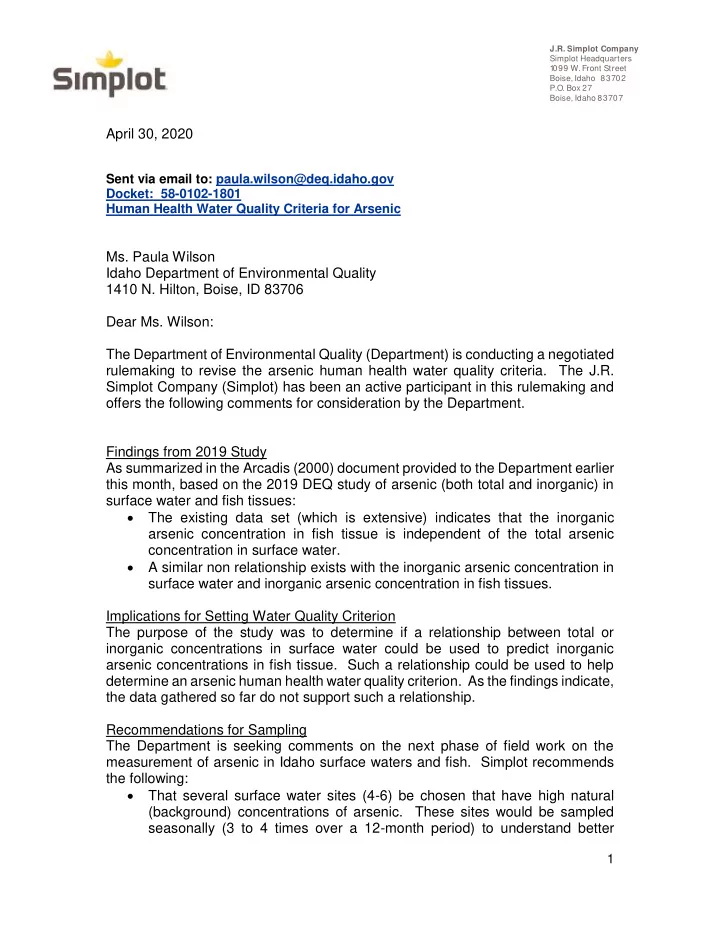

J.R. Simplot Company Simplot Headquarters 1 099 W. Front Street Boise, Idaho 83702 P.O. Box 27 Boise, Idaho 83707 April 30, 2020 Sent via email to: paula.wilson@deq.idaho.gov Docket: 58-0102-1801 Human Health Water Quality Criteria for Arsenic Ms. Paula Wilson Idaho Department of Environmental Quality 1410 N. Hilton, Boise, ID 83706 Dear Ms. Wilson: The Department of Environmental Quality (Department) is conducting a negotiated rulemaking to revise the arsenic human health water quality criteria. The J.R. Simplot Company (Simplot) has been an active participant in this rulemaking and offers the following comments for consideration by the Department. Findings from 2019 Study As summarized in the Arcadis (2000) document provided to the Department earlier this month, based on the 2019 DEQ study of arsenic (both total and inorganic) in surface water and fish tissues: The existing data set (which is extensive) indicates that the inorganic arsenic concentration in fish tissue is independent of the total arsenic concentration in surface water. A similar non relationship exists with the inorganic arsenic concentration in surface water and inorganic arsenic concentration in fish tissues. Implications for Setting Water Quality Criterion The purpose of the study was to determine if a relationship between total or inorganic concentrations in surface water could be used to predict inorganic arsenic concentrations in fish tissue. Such a relationship could be used to help determine an arsenic human health water quality criterion. As the findings indicate, the data gathered so far do not support such a relationship. Recommendations for Sampling The Department is seeking comments on the next phase of field work on the measurement of arsenic in Idaho surface waters and fish. Simplot recommends the following: That several surface water sites (4-6) be chosen that have high natural (background) concentrations of arsenic. These sites would be sampled seasonally (3 to 4 times over a 12-month period) to understand better 1
changes in arsenic concentration over the course of a year. 1 These samples would be analyzed for both total and inorganic arsenic. That at each of these sample sites, individual fish (4-6) would be collected for individual tissue (both total and inorganic arsenic) analysis. These data would be helpful to understand the variability in surface water and fish due to natural conditions. Recommendations for Arsenic Human Health Criterion At this time Simplot does not have a specific recommendation as to the establishment of a new human health water quality criterion for arsenic. Though the existing data does suggest that the ingestion of just water (no ingestion of fish tissues) might be the best technical approach to establish a human health arsenic water quality criteria. Depending on what value is ultimately arrived at for Idaho’s human health water quality criterion for arsenic, gathering further data on surface waters with elevated arsenic concentrations would be helpful in regards to determining “natural conditions” as defined in Idaho’s water quality standards (IDAPA 58.01.02.054.04). The rules (at IDAPA 58.01.02.200.09) do provide for natural background conditions as criteria. However, like for temperature, some de minimis allowance would likely be needed for point sources. Most of Idaho’s drinking water comes from groundwater; this groundwater constitutes the majority of the water treated in wastewater facilities in Idaho. And, just like certain surface waters have elevated arsen ic concentrations from natural sources, the same is true of Idaho’s groundwater. We appreciate the opportunity to provide these comments to the Department. Please contact me at (208) 780-7365 if you have any questions. Sincerely, Alan L. Prouty Vice President, Environmental & Regulatory Affairs CC: Paul Anderson, Arcadis Association of Idaho Cities 1 For example, during “spring run - off” there would be expected to be a change in concentrations due to water volumes and potential “flushing” actions. 2
Idaho Association of Commerce and Industry Idaho Mining Association 3
Recommend
More recommend